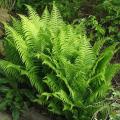Ostrich Fern {flat of 32 Pots - 2 1/2 in}
|
|
Matteuccia struthiopteris (AKA M. pensylvanica, M. pennsylvanica, Pteris nodulosa, S. filicastrum, Osmunda struthiopteris, Onoclea struthiopteris, Fiddlehead Fern, Garden Fern, Hardy Fern, Shuttlecock Fern, Ostrich-Feather Fern)
Pronunciation: mat-TOO-shee-ah stru-thee-OP-ter-iss
Product: 999426
Product: 999426
Shipping description: This product can be shipped to all 48 continental states
FREE SHIPPING!
1-9 flats of 32 2.5" pots: $191.04 ($5.97 per plant)
10-99 flats: $181.49 per flat ($5.67 per plant)
100+ flats: $171.94 per flat ($5.37 per plant)
1-9 flats of 32 2.5" pots: $191.04 ($5.97 per plant)
10-99 flats: $181.49 per flat ($5.67 per plant)
100+ flats: $171.94 per flat ($5.37 per plant)
| (minimum of 1) flat of 32 Pots - 2 1/2 in [ How many plants do I need? ] |
|||
|
|||
Also available as:
 (0)
(0)
 Part sun
Part sun  Shade
Shade